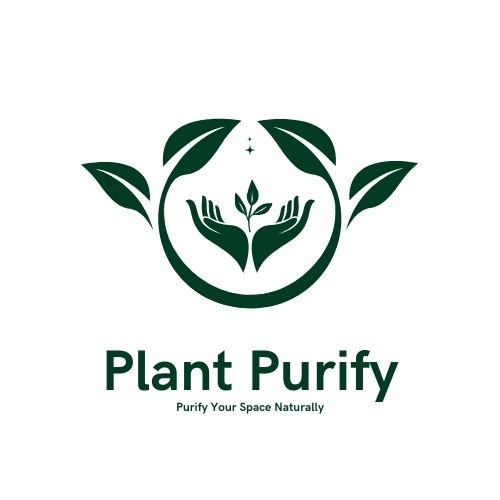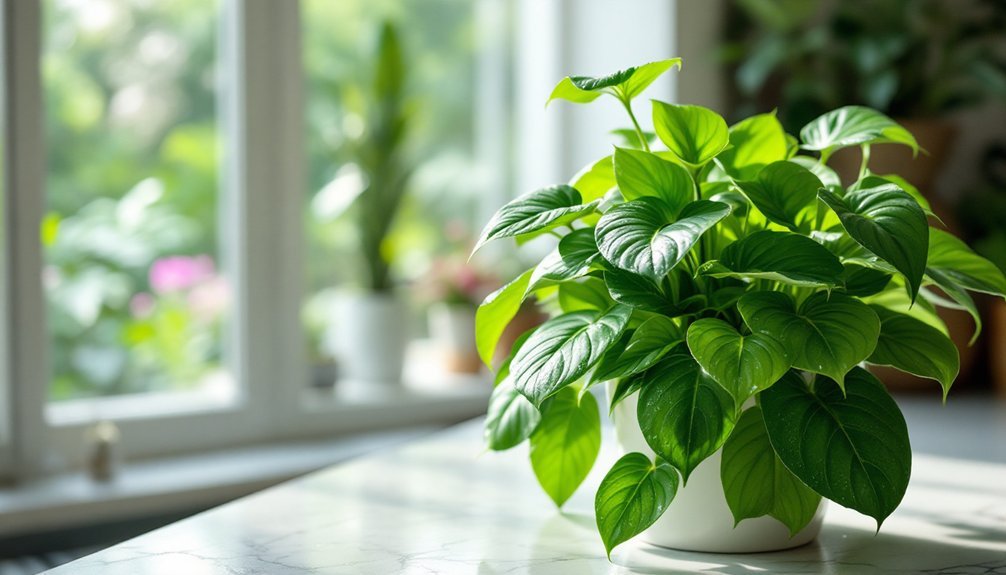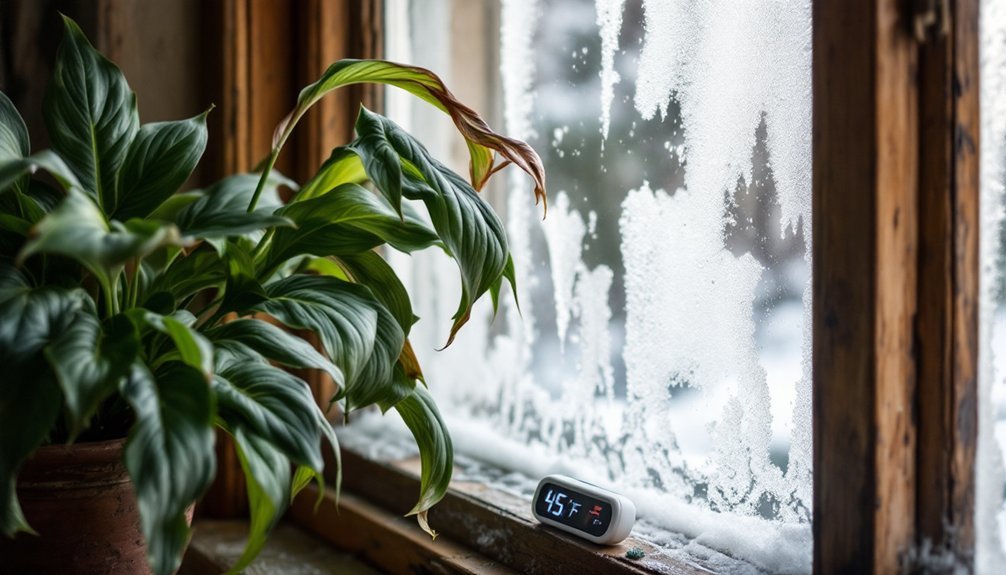ZZ plants are nature's perfect air purifiers thanks to their specialized filtering abilities. You'll find their thick, waxy leaves excel at trapping and neutralizing harmful VOCs like benzene, formaldehyde, and trichloroethylene from your indoor air. Their dual-action purification system works through both leaf absorption and soil microorganism breakdown, while requiring minimal maintenance. Place them strategically in high-traffic areas, and you'll discover why these resilient plants are revolutionary for your home's air quality.
The Science Behind ZZ Plant's Air-Purifying Power

While many houseplants can improve air quality, ZZ plants stand out as particularly effective natural air purifiers. You'll find these plants excel at absorbing volatile organic compounds like benzene, formaldehyde, and trichloroethylene that lurk in your home from everyday products.
The secret to their air purification abilities lies in their unique structure and processes. Your ZZ plant's thick waxy leaves act as natural filters, trapping harmful pollutants and breaking them down into less toxic substances through specialized enzymatic reactions.
What's more, the soil around your plant isn't just there for support – it's teeming with beneficial microbial activity that enhances the plant's air-cleaning power.
Research by Wolverton and colleagues has confirmed that these natural mechanisms greatly reduce indoor air pollutants, making ZZ plants an excellent choice for improving your home's air quality.
Natural Filtering Mechanisms of ZZ Plant Leaves
Beneath their glossy exterior, ZZ plant leaves function as sophisticated natural filters through multiple mechanisms. Their thick, waxy leaves work as a natural air purifier by trapping volatile organic compounds like formaldehyde and benzene, which you'll commonly find in indoor spaces.
You'll appreciate how these leaves don't just clean the air passively. They actively absorb carbon dioxide and convert it to oxygen through photosynthesis, while their unique enzymatic systems transform harmful chemicals into less toxic substances.
The leaves' air-purifying capabilities extend beyond their surface, as they promote beneficial microbial activity in the surrounding soil. Together, these filtering mechanisms create an extensive air purification system that effectively removes common indoor pollutants, making ZZ plants an excellent choice for improving your home or office air quality.
Harmful Indoor Pollutants Absorbed by ZZ Plants

Your home likely contains various sources of volatile organic compounds (VOCs), including fresh paint, cleaning supplies, and synthetic furnishings that release harmful chemicals into the air.
ZZ plants excel at absorbing these toxic compounds, particularly formaldehyde, benzene, and trichloroethylene, through their thick, waxy leaves.
The plant's natural filtering system traps these chemicals and converts them into less harmful substances, making your indoor environment considerably healthier to breathe.
Common Household VOC Sources
Three major VOCs commonly lurk in our homes, posing potential health risks that ZZ plants can help combat.
You'll find these harmful chemicals in everyday items, but your ZZ plants excel at purifying the air by absorbing and metabolizing these compounds through their waxy leaves.
Here's where you're likely to encounter these VOCs in your home:
- Benzene seeps from adhesives, paint thinners, and various household products.
- Formaldehyde emissions come from building materials, furniture, and common household items.
- Trichloroethylene hides in cleaning agents and adhesive products.
- Additional VOC sources include fresh paint, cleaning supplies, and new furniture.
Understanding these sources helps you recognize why ZZ plants are such effective natural air purifiers.
Their ability to trap and process these pollutants makes them invaluable for improving indoor air quality.
Indoor Chemical Absorption Process
Through an intricate biochemical process, ZZ plants excel at trapping and breaking down harmful indoor pollutants. Your ZZ plant's thick, waxy leaves act as natural air purifiers, capturing volatile organic compounds (VOCs) like formaldehyde, benzene, and trichloroethylene that lurk in your home from paints and cleaning products.
The chemical absorption process doesn't stop at the leaves. Your ZZ plant's root system works with beneficial soil microorganisms to transform these toxic compounds into less harmful substances.
This dual-action purification method makes these plants particularly effective at improving your indoor air quality. Scientific research by Wolverton and colleagues confirms that ZZ plants greatly reduce VOC concentrations through their natural filtration abilities, making them an excellent choice for cleaner air in your living spaces.
Photosynthesis and Oxygen Production Benefits
The remarkable process of photosynthesis makes ZZ plants natural air-purifying machines in your home.
You'll notice improved air quality as these efficient air-purifying plants convert carbon dioxide into fresh oxygen, even in low-light conditions. Their thick, waxy leaves are perfectly designed for ideal gas exchange, making them exceptional oxygen producers for your indoor spaces.
Here's how your ZZ plant works to purify your air:
- Absorbs carbon dioxide and releases oxygen through photosynthesis
- Filters out harmful compounds from your indoor environment
- Maintains healthy oxygen levels throughout the day
- Reduces airborne irritants that affect your respiratory health
You'll breathe easier knowing your ZZ plant is constantly working to create a healthier living space through its natural air-purifying abilities and steady oxygen production.
ZZ Plant's Role in Humidity Regulation

While many houseplants struggle to maintain consistent moisture output, ZZ plants excel at regulating indoor humidity through their specialized transpiration process.
Their thick, waxy leaves efficiently release moisture vapor into the air while preventing excessive water loss, making them superior natural humidifiers for your home.
You'll notice the benefits of your ZZ plant's humidity regulation particularly during winter months when heating systems can create dry indoor conditions.
The moisture released by these plants helps create a more comfortable environment and can reduce your risk of respiratory issues.
What's more, your ZZ plant's contribution to ideal humidity levels enhances the overall air purification process in your space.
Comparing ZZ Plants to Other Air-Purifying Species
Looking at the top performers in air purification, you'll find ZZ plants holding their own against heavy hitters like Snake Plants and Peace Lilies in removing harmful VOCs from indoor spaces.
While many air-purifying plants require specific care routines, ZZ plants stand out for their ability to thrive in low light and drought conditions, making them more practical than demanding options like Gerbera Daisies or Marble Queen Pothos.
Your ZZ plant works doubly hard by not only filtering toxins through its waxy leaves but also releasing oxygen at night, a valuable feature it shares with only a select few other air-purifying species.
Plant Filtration Power Rankings
Among popular air-purifying houseplants, ZZ plants hold a respectable but not leading position in filtration effectiveness. While they're excellent at absorbing volatile organic compounds through their waxy leaves, other plants demonstrate superior indoor air quality improvement capabilities.
Here's how ZZ plants rank among top air-purifying contenders:
- Peace Lily and Snake Plant lead the pack with their superior VOC removal abilities
- Spider Plant and Golden Pothos follow with rapid filtration rates due to faster growth
- English Ivy and Gerbera Daisy excel at targeting specific pollutants
- ZZ plants and Marble Queen Pothos share similar plant filtration capabilities
Though ZZ plants don't top the charts, their resilience and low-maintenance nature, combined with their proven ability to metabolize pollutants and support beneficial soil microbes, make them valuable additions to your indoor air-purifying arsenal.
Top Purification Performers Analyzed
Because air-purifying plants vary in their filtration capabilities, understanding how ZZ plants stack up against other species reveals their true value in indoor environments. You'll find that ZZ plants match the air purification strength of top performers like Peace Lilies and Snake Plants, especially in removing VOCs through their waxy leaves.
| Plant Species | VOC Removal | Light Needs |
|---|---|---|
| ZZ Plant | High | Low |
| Peace Lily | High | Medium |
| Snake Plant | High | Low |
| English Ivy | Very High | High |
| Gerbera Daisy | Very High | High |
While some indoor plants require bright conditions to maximize their air-cleaning abilities, your ZZ plant will effectively filter air even in dim corners. This adaptability, combined with its powerful VOC-removing capabilities, makes it an excellent choice for improving air quality throughout your home.
Optimal Placement for Maximum Air Filtration

Strategic placement of ZZ plants throughout your home can maximize their air-purifying potential.
To improve air quality effectively, you'll want to position these natural air purifiers in locations where they'll have the most impact on absorbing harmful pollutants.
For ideal placement of your ZZ plants:
- Set them in bedrooms and frequently used rooms where you spend most of your time.
- Distribute them across multiple floors, including basements and attics, to combat pollution at every level.
- Position them near windows that receive at least 4 hours of direct sunlight daily.
- Place them strategically in areas prone to mold or chemical exposure, such as laundry rooms or near cleaning supply storage.
Remember to monitor your plants' health regularly, as robust ZZ plants are more efficient at air purification.
Chemical Compounds Neutralized by ZZ Plants
Your ZZ plant works tirelessly to break down formaldehyde through specialized enzymes that convert this toxic compound into harmless materials within its leaf tissues.
The plant's waxy leaves excel at trapping benzene molecules, which are then processed through the plant's natural metabolic pathways to neutralize their harmful effects.
Through similar biological mechanisms, your ZZ plant actively absorbs trichloroethylene from the air, transforming this dangerous chemical into safer compounds with the help of beneficial soil microorganisms.
Formaldehyde Removal Process
ZZ plants employ three distinct biochemical pathways to neutralize formaldehyde, making them highly effective air purifiers for your indoor spaces.
Their remarkable air-purifying abilities work through a sophisticated process that you'll find fascinating.
Here's how your ZZ plant removes formaldehyde and other VOCs:
- The waxy leaves trap airborne formaldehyde particles, preventing them from circulating in your indoor air.
- Internal enzymes break down the captured formaldehyde into less harmful compounds.
- The plant's tissue metabolizes these compounds through specialized biochemical pathways.
- Beneficial microorganisms in the soil around your ZZ plant further break down any remaining toxic substances.
This thorough process considerably improves your indoor air quality, as confirmed by Wolverton's research, making ZZ plants an excellent choice for naturally purifying your living space.
Benzene Absorption Mechanisms
Powerhouse purifiers in the plant world, ZZ plants excel at neutralizing benzene through multiple absorption mechanisms.
You'll find these air-purifying champions particularly effective at tackling indoor benzene, a harmful VOC commonly found in paints and cleaning products.
Your ZZ plant's thick, waxy leaves serve as natural capture points, trapping benzene molecules before they can circulate through your space.
What's fascinating is how these plants don't just trap the compounds – they transform them.
The leaves work in tandem with beneficial soil microbes to break down the captured benzene through specialized enzymatic processes.
This dual-action approach makes ZZ plants remarkably efficient at converting these harmful compounds into less dangerous substances, actively improving your indoor air quality while adding a touch of green to your space.
Trichloroethylene Breakdown Actions
Diving into another remarkable purification process, trichloroethylene meets its match in the sophisticated chemical breakdown mechanisms of ZZ plants.
You'll find that these resilient plants employ multiple strategies to combat this common industrial solvent, greatly improving your indoor air quality.
Here's how your ZZ plant tackles trichloroethylene:
- The plant's waxy leaves act as natural traps, capturing trichloroethylene molecules from the surrounding air.
- Internal biochemical pathways metabolize the trapped compounds into less harmful substances.
- The plant's natural processes convert these industrial pollutants into safer byproducts.
- Beneficial microorganisms in the soil around your ZZ plant assist in breaking down remaining trichloroethylene.
This extensive air purifying system makes your ZZ plant an efficient natural filter, actively working to create a healthier indoor environment for you and your family.
Root System's Impact on Indoor Air Quality
While many houseplants can improve air quality, the unique root structure of the ZZ plant sets it apart as a particularly effective air purifier. The thick, potato-like rhizomes don't just store water—they create an ideal environment for beneficial microorganisms that break down air pollutants. These specialized roots work with soil microbes to metabolize harmful compounds like formaldehyde and benzene, considerably enhancing your indoor air quality.
| Root Feature | Function | Benefit |
|---|---|---|
| Rhizomes | Water Storage | Drought Resistance |
| Microbial Zone | VOC Breakdown | Air Purification |
| Dense Structure | Nutrient Absorption | Enhanced Growth |
| Soil Integration | Microbe Support | Pollutant Removal |
| Deep System | Stability | Long-term Health |
You'll find that this remarkable root system, combined with the plant's waxy leaves, creates a powerful natural air-cleaning mechanism that actively improves your home's atmosphere.
Research Studies Supporting ZZ Plant Effectiveness

Scientific research has consistently validated the ZZ plant's reputation as an effective air purifier. You'll find compelling evidence in studies like Wolverton et al. (1989), which demonstrates how these plants actively remove volatile organic compounds from your indoor spaces.
The ZZ plant's air purification capabilities are supported by four key findings:
- The plant's thick, waxy leaves effectively trap and break down airborne pollutants.
- Internal enzymatic processes convert harmful chemicals like formaldehyde into less toxic substances.
- Beneficial microorganisms in the plant's soil help degrade various pollutants.
- The plant specifically targets common indoor air pollutants such as benzene and formaldehyde.
While you shouldn't rely solely on ZZ plants for complete air purification, research confirms they're valuable contributors to improving your indoor air quality through their natural filtering processes.
Maintaining Your Living Air Purifier
Now that you understand the science behind ZZ plants' air-purifying abilities, maintaining these natural filtration systems requires specific but straightforward care.
Your ZZ plant will thrive with minimal attention, making it an ideal low maintenance air purifier for any indoor space.
Place your plant in an area with indirect sunlight to maintain its air-cleaning effectiveness.
Allow the soil to dry completely between waterings to prevent root rot, which can compromise its purifying capabilities.
Watch for yellowing leaves, as they're indicators that your plant needs care adjustments.
To expand your home's air filtration network, consider propagating your ZZ plant by dividing its rhizomes during repotting.
You can strategically position multiple plants throughout your living spaces to maximize their air-purifying benefits.
Frequently Asked Questions
Are ZZ Plants Good Air Purifiers?
Yes, your ZZ plant's thick leaves effectively absorb harmful VOCs like formaldehyde and benzene, improving indoor air quality. While they're good natural purifiers, don't rely on them as your only air-cleaning solution.
What Is the Most Efficient Air Purifying Plant?
While the Snake Plant (Sansevieria) is often considered the most efficient air purifier, you'll find it removes up to 87% of air toxins. It's followed closely by Spider Plants and Peace Lilies.
What Are the Benefits of Having a ZZ Plant in Your House?
You'll enjoy cleaner air as your ZZ plant removes harmful VOCs like formaldehyde and benzene. It'll boost oxygen levels, reduce allergies, regulate humidity, and require minimal maintenance while improving your home's overall atmosphere.
Is a ZZ Plant Good for Oxygen?
Yes, your ZZ plant's a great oxygen producer. Through photosynthesis, it'll convert carbon dioxide into oxygen, helping purify your indoor air. Its thick, waxy leaves are particularly efficient at this natural process.
In Summary
ZZ plants are your natural air-cleaning powerhouses that'll work around the clock in your home. You'll breathe easier knowing these low-maintenance plants are filtering out harmful VOCs, regulating humidity, and producing fresh oxygen. By keeping your ZZ plant healthy with proper care, you're maintaining a highly effective living air purifier that'll continue improving your indoor air quality for years to come.





Leave a Reply